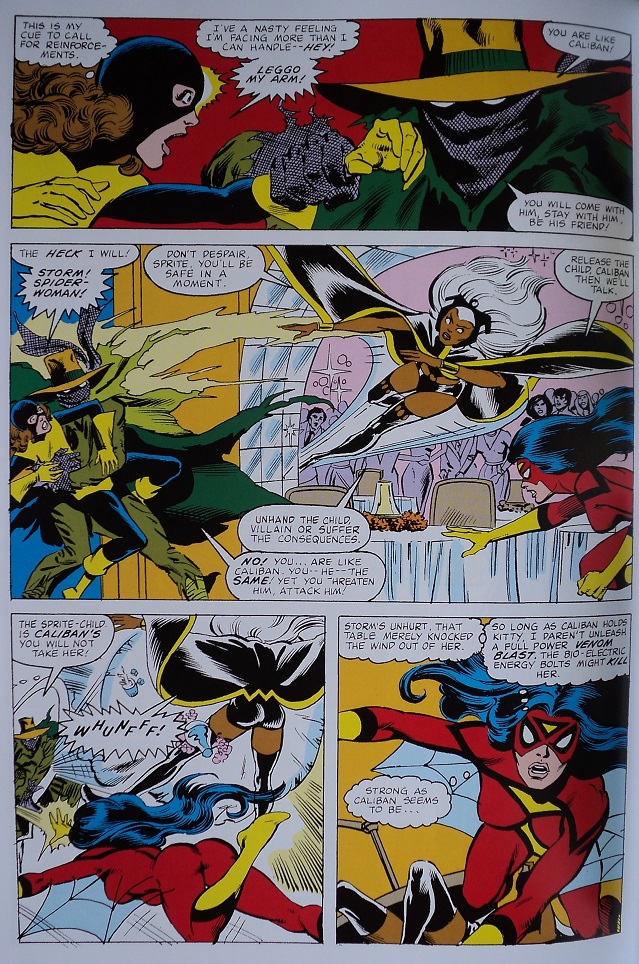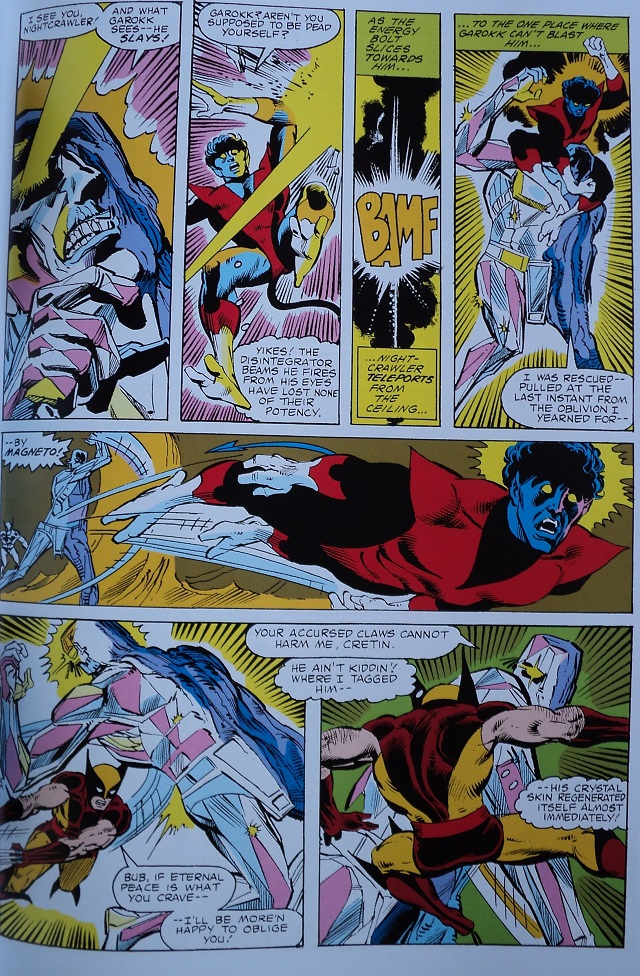A few years ago, I started reviewing the classic Chris Claremont and Dave Cockrum run on this blog, beginning with Second Genesis, the story that brought us the X-Men team most fans are familiar with (Wolverine, Storm, Colossus, Cyclops, etc.). I gladly reviewed those issues as a steppingstone towards the run I was truly interested in: Chris Claremont and John Byrne, which didn’t just redefine the X-Men title but the entire superhero genre. I honestly don’t think we could find anything as grandiose, as vibrant and as classic as those X-Men issues co-written by Claremont and Byrne, and beautifully illustrated by Byrne.
 |
| Dave Cockrum |
However, as the saying goes, all good things must come to an end, Byrne’s departure after Uncanny X-Men # 143 meant that Claremont regained full control of the title, which he had reluctantly relinquished to appease the creative demands of superstar John Byrne. As a I said before, this obviously meant a change in tone and style. I will have to admit that it feels quite strange to see Cockrum returning to a title that became the bestselling comic thanks to Byrne. I wonder if it was difficult for the veteran artist to come back to a place that had been elevated by the talent of someone who, out of modesty, didn’t consider himself more than a pupil. This was a good example of a student besting his teacher. And as much as I appreciate Cockrum’s art, whenever I read these comics I can’t stop missing Byrne.
 |
| Dave Cockrum |
“Cry, Mutant” (originally published in Uncanny X-Men # 148, August 1981), written by Chris Claremont, penciled by Dave Cockrum, inked by Joe Rubinstein and colored by Glynis Wein, introduces Caliban (named after one of the main characters in Shakespeare’s Tempest). In later decades, Caliban will become a major player in Peter David’s X-Factor, but here he’s merely a secondary character. Most important, perhaps, is the fact that Caliban admits that he lives in an ‘underworld home’, clearly a reference to the large amount of mutants living underground, in the sewers of New York city, a premise Claremont will elaborate further in subsequent years.
Another important plotline shows us Cyclops running around in an ancient city which has existed long before humans stepped foot on this world. In a magnificent double page spread, Cockrum shows us the design of this nightmarish city, which is a clear homage to H.P. Lovecraft’s Cthulhu Mythos. This plotline continues in “And the Dead Shall Bury the Living” (Uncanny X-Men # 149, September 1981), written by Chris Claremont, penciled by Dave Cockrum, inked by Joe Rubinstein, and colored by Don Warfield. Here, a confrontation between the X-Men and the powerful Garokk announces the presence of Magneto.
 |
| Scott Summers |
The last comic included in The Uncanny X-Men Omnibus Vol. 2 is “I, Magneto” (Uncanny X-Men # 150, October 1981). Since I decided to buy both omnibus volumes exclusively because of my interest in John Byrne’s run, I’m still unsure about whether or not I should purchase the third volume (something tells me I might end up doing it sooner rather than later). The protagonist of this issue is the X-Men’s greatest nemesis, the master of magnetism, Magneto himself. Claremont writes it, Cockrum pencils it, and Joe Rubinstein and Bob Wiacek inks it, while Glynis Wein colors it.
 |
| Caliban |
First, we see Magneto in one of his many megalomaniac monologues about destroying the world. One of my favorite sequences happens when the X-Men arrive to the ancient city in which Cyclops has been wandering around. Storm gains access to Magneto’s quarters, and there, under the darkness of the night, she plots to kill him. It’s an intense moment in which storms questions herself about the morality of what she’s about to do, and Magneto’s quick reaction proves how lethal he can be as an enemy. The X-Men will fight against Magneto, as can be expected.
 |
| Kitty Pride, Caliban, Spider-Woman & Storm |
The best sequence comes after the confrontation, when for one second Magento regains his own sense of humanity: “In my zeal to remake the world, I have become much like those I have always hated and despised”, he admits. To which Storm replies “The dream was good, is good. Only the dreamer has become corrupted”. The circle is completed, from an initial outburst of hate that made Magneto threaten the world and Storm try to murder him in his sleep, to challenging our innermost perceptions, of ourselves and the world around us. I think in moments like this, Claremont shines as a writer.
________________________________________________________________________________________________________
________________________________________________________________________________________________________
Hace unos años, comencé a reseñar la etapa clásica de Chris Claremont y Dave Cockrum en este blog, comenzando con Second Genesis, la historia que nos trajo el equipo de X-Men con el que la mayoría de los fanáticos están familiarizados (Wolverine, Storm, Colossus, Cyclops, etc. .). Con mucho gusto reseñé esos cómics como un trampolín hacia la etapa que realmente me interesaba: Chris Claremont y John Byrne, quien no solo redefinió el título de X-Men sino todo el género de superhéroes. Honestamente, no creo que podamos encontrar algo tan grandioso, tan vibrante y tan clásico como esos números de X-Men coescritos por Claremont y Byrne, y bellamente ilustrados por Byrne.
 |
| Garokk |
Sin embargo, como dice el refrán, todo lo bueno debe llegar a su fin, la partida de Byrne después de Uncanny X-Men # 143 significó que Claremont recuperó el control total del título, al que había renunciado a regañadientes para apaciguar las demandas creativas de la superestrella John Byrne. Como dije antes, esto obviamente significó un cambio de tono y estilo. Debo admitir que resulta bastante extraño ver a Cockrum regresar a un título que se convirtió en el cómic más vendido gracias a Byrne. Me pregunto si al veterano artista le resultó difícil regresar a un lugar que había sido encumbrado por el talento de alguien que, por pudor, no se consideraba más que un alumno suyo. Este fue un buen ejemplo de un estudiante superando a su maestro. Y por mucho que aprecio el arte de Cockrum, cada vez que leo estos cómics no puedo dejar de añorar a Byrne.
“Llora, mutante” (publicado originalmente en Uncanny X-Men # 148, agosto de 1981), escrito por Chris Claremont, dibujado a lápiz por Dave Cockrum, entintado por Joe Rubinstein y coloreado por Glynis Wein, presenta a Caliban (que lleva el nombre de uno de los personajes principales de La tempestad de Shakespeare). En décadas posteriores, Caliban se convertirá en un actor importante en X-Factor de Peter David, pero aquí es simplemente un personaje secundario. Lo más importante, quizás, es el hecho de que Caliban admite que vive en una “casa del inframundo”, claramente en referencia a la gran cantidad de mutantes que viven subterráneamente, en las alcantarillas de la ciudad de New York, una premisa que Claremont desarrollará más en los años siguientes.
 |
| Storm & Magneto |
Otra trama importante nos muestra a Cyclops corriendo por una ciudad antigua que existió mucho antes de que los humanos pusieran pie en este mundo. En una magnífica doble página, Cockrum nos muestra el diseño de esta ciudad de pesadilla, en un claro homenaje a Los mitos de Cthulhu de H.P. Lovecraft. Esta trama continúa en “Y los muertos enterrarán a los vivos” (Uncanny X-Men # 149, setiembre de 1981), escrita por Chris Claremont, dibujada por Dave Cockrum, entintada por Joe Rubinstein y coloreada por Don Warfield. Aquí, un enfrentamiento entre los X-Men y el poderoso Garokk anuncia la presencia de Magneto.
 |
| Wolverine, Nightcrawler, Kitty Pride, Colossus & Cyclops |
El último cómic incluido en The Uncanny X-Men Omnibus Vol. 2 es “Yo, Magneto” (Uncanny X-Men # 150, octubre de 1981). Dado que decidí comprar ambos volúmenes de lujo en tapa dura, exclusivamente debido a mi interés en la etapa de John Byrne, todavía no estoy seguro de si debería o no comprar el tercer volumen (algo me dice que podría terminar haciéndolo más temprano que tarde). El protagonista de este número es el mayor enemigo de los X-Men, el maestro del magnetismo, el propio Magneto. Claremont lo escribe, Cockrum lo dibuja a lápiz y Joe Rubinstein y Bob Wiacek lo entintan, mientras Glynis Wein lo colorea.
Primero, vemos a Magneto en uno de sus muchos monólogos megalómanos hablando sobre la destrucción del mundo. Una de mis secuencias favoritas ocurre cuando los X-Men llegan a la antigua ciudad por la que Cyclops ha estado deambulando. Storm obtiene acceso a las habitaciones de Magneto y allí, bajo la oscuridad de la noche, planea matarlo. Es un momento intenso en el que Storm se cuestiona sobre la moralidad de lo que está a punto de hacer, y la rápida reacción de Magneto demuestra lo letal que puede ser como enemigo. Los X-Men lucharán contra Magneto, como era de esperar.
 |
| Professor X & Moira MacTaggert |
La mejor secuencia llega después del enfrentamiento, cuando por un segundo Magneto recupera su propio sentido de humanidad: “En mi afán por rehacer el mundo, me he vuelto muy parecido a aquellos que siempre he odiado y despreciado”, admite. A lo que Storm responde “El sueño fue bueno, es bueno. Sólo el soñador se ha corrompido”. El círculo se completa, desde un estallido inicial de odio que hizo que Magneto amenazara al mundo y Storm intentara asesinarlo mientras dormía, hasta desafiar nuestras percepciones más íntimas, de nosotros mismos y del mundo que nos rodea. Creo que en momentos como éste, Claremont brilla como escritor.














